A hike up Dix Mountain in the Adirondacks (4840 feet and sixth highest in region) from Route 73 is about 14 miles round trip. It takes a puttering 50 year old rock gardener on a mission about eight hours to complete and still see lots of good plants. On the way up: Gentiana andrewsii(?) in an alder swamp and Eupatorium sp. in a marsh.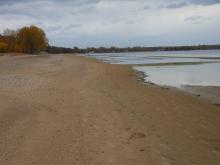

Looking up from the base of a slide on the north face of Dix. A few disoriented hikers actually followed one obsessed plant geek up the slide! I think there are more hikers than ever in the Adirondacks these days. And, an example of sharp deliniation in rock types proving that it's not unatural to put different colored rockeries together in the same garden!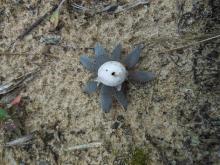
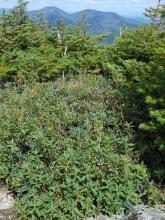
Red spruce in a crevice and, I think, one of the most surprising things on this slide; Drosera rotundifolia in a crevice! There's many more examples of this normally bog dwelling plant scattered about.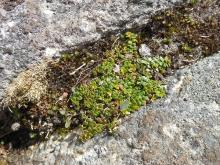
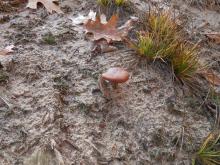
The upper slopes take on characteristic of a boreal rain forest. Here's a near perfect Boletus.
I saw no globally rare species up here. However, there are plants (disjunct) that are at the southwestern limit of their distribution. There's a lot of soil on the summit of Dix so not too much good habitat for alpines as krumholz spruce and fir move in. Evidence suggests that people could be a bit more careful.
Vaccinium uliginosum in moss, and, at bottom of second photo, one of only a few Empetrum nigrum on Dix.

Comments
Michael Peden
Re: Adirondack Mountains: A hike up Dix Mountain
Sun, 08/19/2012 - 7:27amMinuartia groenlandica is the most common, arguably the only, small cushion plant on Dix. A few still had flowers in August. The second photo of miniature garden including Ledum groenlandicum and Cornus canadensis.
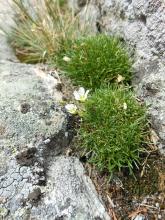
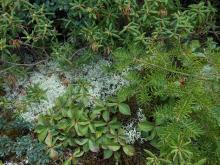
Kalmia angustifolia and Gaultheria hispidula making go of a crevice. The later usually grows in shady moist spots and is more robust.


The thick layer of peaty soil exposed and rattlesnake rocks!
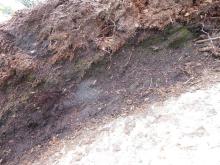
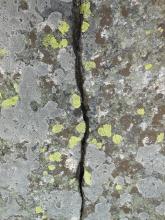
How the earth views the sky and the view east from the summit.
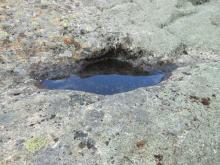
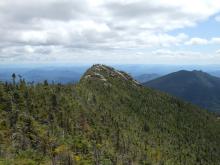
In the woods below; Mr. Beaver is a good architect! And, a Saint Johnswort in seed; perhaps H.ellipticum on top of his dam.
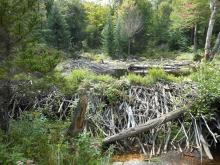
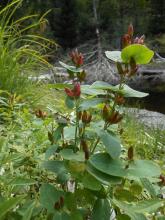
Mark McDonough
Re: Adirondack Mountains: A hike up Dix Mountain
Sun, 08/19/2012 - 7:33amBeautiful scenery and terrain, I too would be tempted to walk up that slide. Last year there was lots of discussion on the differences between Gentiana clausa and G. andrewsii in a topic called "Bottle Gentians".
http://nargs.org/smf/index.php?topic=418.msg4325#msg4325
I dont see the little ragged "tuft" at the very top of the bottle flowers, characteristic for G. andrewsii, so my guess is Gentiana clausa.
Cool Hypericum with those rounded leaves, I was not aware of H. ellipticum, I'm a real fan of the native woody Hypericum species. Googling, I'm not sure that it matches H. ellipticum which looks to be a smaller herbaceous plant, so I wondering what the other identification possibilities are... maybe Hypericum punctatum.
Lori S. (not verified)
Re: Adirondack Mountains: A hike up Dix Mountain
Sun, 08/19/2012 - 8:34amIt's great to see that part of the world, Michael - thanks for posting your hike! What an interesting combination of rich woodland with subalpine and alpine tundra. I love the photo of the bunchberry, and also the photo and description of the earth gazing at the sky!
Michael Peden
Re: Adirondack Mountains: A hike up Dix Mountain
Sun, 08/19/2012 - 3:30pmThanks Mark, I knew I was entering risky waters with that evaluation. I'm not even sure it's a Hypericum but it must be in the family. It does look to be a good plant, and in my experience, unusual (though providing a beaver dam in the garden might be tricky). Now to catch it in flower.
Mark McDonough
Re: Adirondack Mountains: A hike up Dix Mountain
Sun, 08/19/2012 - 5:29pmI do think it is a Hypericum. What I do in such cases of trying to ID a plant, is google something like "USDA Hypericum", which shows a list of all species in North America (excluding Mexico), each showing a US range map with States indicated. Then it is short order to check out each species that grows in a State like New York State, to narrow the possibilities. Various Hypericum have been flowing in and out of Hypericum and several other genera (botanists just can't make up their minds), but I would bet money that the nice plant you show is H. punctatum. Now to catch it in seed ;-)
Trond Hoy
Re: Adirondack Mountains: A hike up Dix Mountain
Mon, 08/20/2012 - 1:35pmMost interesting, Michael. The terrain and the plants are familiar in a way but very unfamiliar too!
cohan (not verified)
Re: Adirondack Mountains: A hike up Dix Mountain
Tue, 08/21/2012 - 12:02pmNice hike, Michael- something especially appealing about disjunct habitat!
The only time I've seen Drosera in person was a similar habitat near a lakeshore in Ontario..
'How the earth views the sky' very poetic!